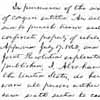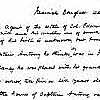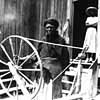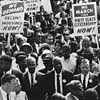
African-American History and Culture
The Manuscript Division has one of the nation's most valuable collections for the study of African-American history and culture. The Library's holdings include information about slavery and the slave trade as well as other aspects of plantation life. Papers of slaveholders provide one view of slavery, and slave narratives give another. Diaries and journals further illuminate lives spent in slavery and freedom. The manuscripts of black and white abolitionists such as Frederick Douglass and Salmon P. Chase describe the efforts of those who attempted to alleviate the plight of slaves, and the records of the American Colonization Society detail the saga of African Americans who left the United States and established the West African nation of Liberia in the mid- nineteenth century. Papers relating to black participation and victimization in the Civil War abound, and African-American history during Reconstruction is reflected in collections pertaining to newly elected black officials such as John Mercer Langston, Blanche K. Bruce, Hiram R. Revels, and Francis L. Cardozo.
 Abraham Lincoln's preliminary draft of the
Emancipation
Proclamation was shown to his Cabinet in July 1862. [Page 2] In
it, Lincoln warns that if the rebellion is not ended in
four months, as a "necessary military measure" he will
"order and declare . . . all persons held as slaves
within any state or states, wherein the constitutional
authority of the United States shall not be practically
recognized, submitted to, and maintained, shall then,
thenceforward, and forever be free." (Abraham Lincoln
Papers)
Abraham Lincoln's preliminary draft of the
Emancipation
Proclamation was shown to his Cabinet in July 1862. [Page 2] In
it, Lincoln warns that if the rebellion is not ended in
four months, as a "necessary military measure" he will
"order and declare . . . all persons held as slaves
within any state or states, wherein the constitutional
authority of the United States shall not be practically
recognized, submitted to, and maintained, shall then,
thenceforward, and forever be free." (Abraham Lincoln
Papers)
Efforts by African-Americans to educate themselves and find meaningful employment can be traced in the papers of historian Carter G. Woodson and educator Nannie Helen Burroughs. Also available are the papers of the first three presidents of Tuskegee Institute--Booker T. Washington, Robert Russa Moton, and Frederick D. Patterson. The papers of Gen. Noel F. Parrish--the white World War II commander of the Tuskegee air base where black airmen were trained by the army air corps for the first time--reveal how blacks and whites worked together to dispel racist presumptions of black inferiority. Information on the training of black aviators and the establishment of the Tuskegee flight school may also be found in the diaries of historian Rayford W. Logan, who in the early 1940s was acting chair of the Committee on Participation of Negroes in the National Defense Program.
Logan is best known as a historian and professor at Howard University, but like other prominent black educators he was also involved in civil rights activities. The papers of historian Lorenzo J. Greene, who taught for many years at Lincoln University in Missouri, similarly reflect his involvement in the National Urban League (NUL) and the National Association for the Advancement of Colored People (NAACP), his participation on two different presidential commissions concerning the status of blacks and children, and his authorship of an important study on school desegregation for the United States Civil Rights Commission. The papers of Kenneth Bancroft Clark also reveal a college professor and social psychologist whose concern with the psychology of racism brought him national attention in the post-World War II era, when his research on the detrimental effects of segregation was cited in the 1954 Supreme Court decision Brown v. Board of Education of Topeka, Kansas.
 This manuscript (ca. 1891) of an autobiographical
article
is in the hand of Frederick Douglass, who prepared it for
The National Cyclopedia of American Biography.
Douglass
was born a slave in Talbot County, Maryland, but escaped
in 1838 and eventually became a renowned abolitionist,
orator, journalist, and public official. In 1845 he
published a full-length autobiography and subsequently
produced two revised versions. Drafts of these are among
his papers held in the Manuscript Division. (Frederick
Douglass Papers)
This manuscript (ca. 1891) of an autobiographical
article
is in the hand of Frederick Douglass, who prepared it for
The National Cyclopedia of American Biography.
Douglass
was born a slave in Talbot County, Maryland, but escaped
in 1838 and eventually became a renowned abolitionist,
orator, journalist, and public official. In 1845 he
published a full-length autobiography and subsequently
produced two revised versions. Drafts of these are among
his papers held in the Manuscript Division. (Frederick
Douglass Papers)
The division's collections are particularly strong for the history of the twentieth-century civil rights movement. The work of individual activists, rights organizations, and jurists is well represented. The NAACP and the NUL were founded in the first decade of the twentieth century and became important vehicles for the advancement of civil rights for blacks in the United States. Both, in turn, selected the Library of Congress as the repository for their records. While the NUL has tended to concentrate its efforts in the area of equal employment opportunities for blacks, the NAACP has moved forward on many fronts and has been most successful in its drive for equal legal protection. The NAACP led the struggle for the abolition of segregation, discrimination, lynching, and other forms of racial oppression.
 This photograph of former slave
Lucindy Lawrence Jurdon
accompanied the transcript of an oral history interview
conducted with her during the 1930s as part of the ex-slave
narrative program of the Work Projects
Administration's Federal Writers Project. In seventeen
states WPA workers interviewed hundreds of African
Americans born before the passage of the Thirteenth
Amendment outlawing slavery in 1865. Some of the
informants were infants and small children when the Civil
War ended, but others were old enough to have experienced
and remembered many aspects of slavery. The narratives
often are as interesting to historians studying the
history of African Americans in the 1930s as to scholars
examining the antebellum period. (United States Work
Projects Administration, Federal Writers Project Records)
This photograph of former slave
Lucindy Lawrence Jurdon
accompanied the transcript of an oral history interview
conducted with her during the 1930s as part of the ex-slave
narrative program of the Work Projects
Administration's Federal Writers Project. In seventeen
states WPA workers interviewed hundreds of African
Americans born before the passage of the Thirteenth
Amendment outlawing slavery in 1865. Some of the
informants were infants and small children when the Civil
War ended, but others were old enough to have experienced
and remembered many aspects of slavery. The narratives
often are as interesting to historians studying the
history of African Americans in the 1930s as to scholars
examining the antebellum period. (United States Work
Projects Administration, Federal Writers Project Records)
The NAACP headquarters and Washington bureau records include more than two million items, which provide a rich source for the social history of black Americans in the twentieth century. In addition to these organizational records, the division holds the personal papers of some of the individuals who worked closely with the NAACP such as Moorfield Storey, the association's first president; Arthur B. Spingarn, its third president; and Roy Wilkins, longtime administrator and executive director from 1965 to 1977. The division also holds the records of the NAACP Legal Defense and Educational Fund, which was created by the NAACP just before World War II but eventually became independent of the parent organization. The fund's records document its presence at the forefront of the legal struggle for civil rights. Complementing these records are the personal papers of Justice Thurgood Marshall, who was the special counsel and director of the fund from its creation until 1961, when President John F. Kennedy appointed him to the United States Court of Appeals for the Second Circuit.
Other important civil rights activists and organizations represented in the Manuscript Division include the Brotherhood of Sleeping Car Porters, whose records date from 1920 to 1968, and the union's founder, Asa Philip Randolph, who also served as its president from 1925 to 1968. The papers of Bayard T. Rustin, a close associate of Randolph and an apostle of non-violent action, are also in the division's holdings.
 Appearing in the forefront of this photograph of the 1963
March on Washington for Jobs and Freedom are Joseph L.
Rauh, Jr., Washington lawyer and civil rights activist;
Whitney M. Young, Jr., executive director of the National
Urban League (NUL); Roy Wilkins of the National
Association for the Advancement of Colored People
(NAACP); A. Philip Randolph, founder and head of the
Brotherhood of Sleeping Car Porters; and Walter Reuther,
president of the United Automobile Workers Union of
America (UAW). March participants called on President
John F. Kennedy and the Congress to enfranchise African
Americans, and give them equal access to public
facilities, quality education, adequate employment, and
decent housing. Among the division's unparalleled
sources for the study of the twentieth-century civil
rights movement are the personal papers of Rauh, Wilkins,
and Randolph, as well as the organizational records of
the NAACP, the NUL, and the Brotherhood of Sleeping Car
Porters. (Prints and Photographs
Division)
Appearing in the forefront of this photograph of the 1963
March on Washington for Jobs and Freedom are Joseph L.
Rauh, Jr., Washington lawyer and civil rights activist;
Whitney M. Young, Jr., executive director of the National
Urban League (NUL); Roy Wilkins of the National
Association for the Advancement of Colored People
(NAACP); A. Philip Randolph, founder and head of the
Brotherhood of Sleeping Car Porters; and Walter Reuther,
president of the United Automobile Workers Union of
America (UAW). March participants called on President
John F. Kennedy and the Congress to enfranchise African
Americans, and give them equal access to public
facilities, quality education, adequate employment, and
decent housing. Among the division's unparalleled
sources for the study of the twentieth-century civil
rights movement are the personal papers of Rauh, Wilkins,
and Randolph, as well as the organizational records of
the NAACP, the NUL, and the Brotherhood of Sleeping Car
Porters. (Prints and Photographs
Division)
The papers of two well-known political figures, Patricia Roberts Harris and Senator Edward W. Brooke, illustrate the efforts of African Americans to move into the center of the political arena. Harris, the first black woman to hold a Cabinet position, served as Secretary of Housing and Urban Development and Secretary of Health, Education, and Welfare (later called Health and Human Services) under President Jimmy Carter. Brooke was the third black United States senator in the nation's history and the only one elected in this century until Carol Moseley Braun's recent victory.
The division's African-American manuscript collections have served historians well, supporting the much-increased scholarship in black history that began in the 1960s. The NAACP records are annually the most heavily used collection in the division, and other black history collections attract large numbers of scholars, testifying to their importance not only to the Library but to the nation itself.
Ask a Librarian (March 20, 2001)